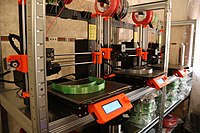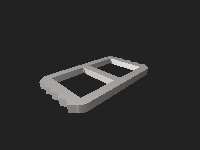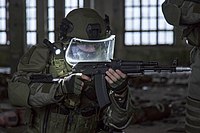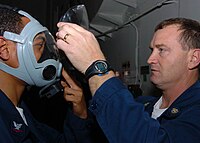
Face shield
A face shield, an item of personal protective equipment (PPE), aims to protect the wearer's entire face (or part of it) from hazards such as flying objects and road debris, chemical splashes (in laboratories or in industry), or potentially infectious materials (in medical and laboratory environments). Depending on the type used, a face shield may protect its wearer from a physical hazard, chemical splashes, or biological hazards. [1]
Two methods are used to manufacture face shields: extrusion and injection molding. Faceshields cut from extrusion sheets provide better impact resistance than injection molded faceshields because extrusion sheets are made of high molecular weight plastic pellets while injection molding must use lower molecular weight plastic pellets, which provide better melt flowing property needed by injection molding. For example, even faceshields 0.8 mm (0.031 in) thick made of extrusion polycarbonate sheets can withstand the impact of a 6 mm (0.24 in) nominal diameter steel ball traveling at the speed 120 m/s (390 ft/s) (European standard, protection against high-speed particles – medium energy impact), while injection molding faceshields must have at least 1.5 mm (0.059 in) thickness to withstand the same impact. But injection molding can provide more complicated shape than extrusion.
During the COVID-19 pandemic, people from 86 countries engaged in the voluntary production of PPE to supplement traditional supply chains - many of which had been interrupted.[3] They collectively produced a total of 25 million face shields with techniques including 3D printing, Laser cutting, Injection molding.[4]
In military or law enforcement environments, a face shield may be designed for ballistic or non-ballistic protection. The non-ballistic shield will provide no protection from projectiles shot from firearms,[6] but is usually designed to withstand low velocity impacts, like caused by punches or thrown objects.[7]
A ballistic face shield is designed to stop or deflect blast and fragments from operators wearing bomb suits[8] To protect the wearers eyes and face from ballistic threats in combat is envisioned in the PEO Soldier program for the United States Department of Defense.[9]
Usage in construction[edit]
On many construction sites many workers use face shields to protect them from debris or sparks. Many tools for cutting and working with metal recommend the use of a face shield. Examples include welding equipment or metal chop saws.

![3D file for printing a face shield[5]](http://upload.wikimedia.org/wikipedia/commons/thumb/b/be/Headpiece.stl/200px-Headpiece.stl.png)



